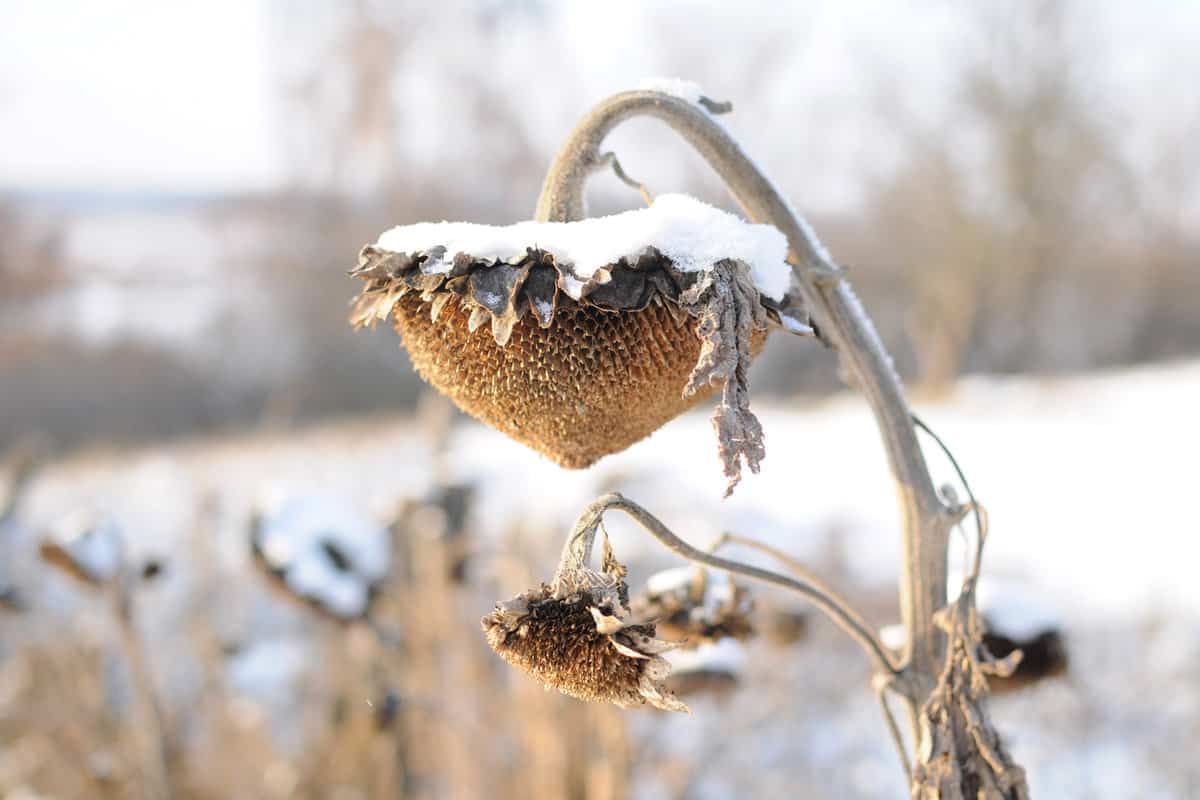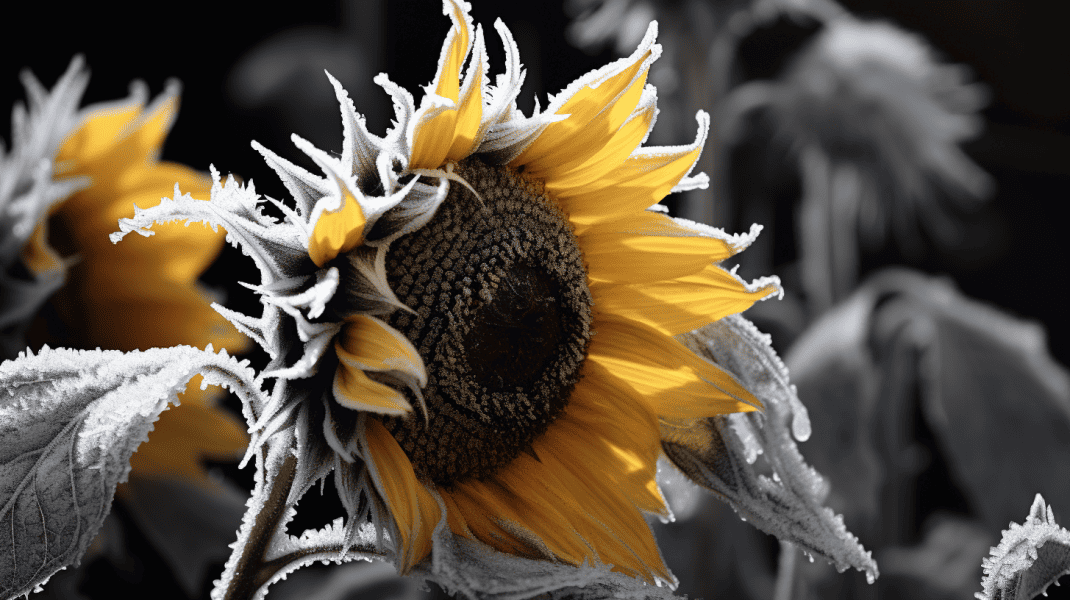With the right winter care, you can have healthy, vigorous sunflowers that return even stronger the next growing season.
To help your sunflowers thrive through winter, be sure to mulch for insulation, support tall stems, cover plants if extremely cold, prune back dead foliage, water before frost, choose cold-hardy varieties, leave mulch until spring, remove spent flowers, and amend the soil.
This article will explain how to properly safeguard your sunflowers through harsh winter conditions. You'll learn the key steps, like mulching for insulation, supporting tall stems, and pruning back dead foliage.
With easy tips on mulching, providing support, cold protection, watering, and more, you'll have the knowledge to overwinter your sunflowers like a pro!
Does My Sunflower Need Protection in the Winter?

Nothing brightens up a garden like cheerful sunflowers. With just a little care, you can protect your plants through the winter so they return healthy and strong when warmer weather arrives.
How Cold is Too Cold for Sunflowers?
Sunflowers can tolerate some pretty chilly temperatures. But bitter cold and hard freezes can damage them over winter. Here are some guidelines on when to take action:
- Mulch plants when overnight lows drop below freezing (below 32°F/0°C) consistently. This insulates roots from frost.
- Add row cover/cloche protection if temperatures remain below 20°F (-7°C) for multiple days and nights in a row. Prolonged extreme cold can kill stems and leaves.
- Move potted plants indoors if lows are expected to drop below 0°F (-18°C). Container plants are more exposed to cold than in-ground ones.
- Provide support when heavy snow or winds over 25 mph are expected. Stems can break under excess weight and force.
- Water whenever the top few inches of soil feel dry. Cold soils still lose moisture from winds.
- Prune and prep plants after first light fall frost. Don’t wait until heavy freezes begin.
- Amend soil 6-8 weeks before ground freezes solid. Nutrients have time to settle in.
Pay attention to long-range forecasts in your area. Be proactive about winter protection as cold sets in. A little preparation goes a long way in ensuring thriving sunflowers next season!

Here are our top tips for getting sunflowers safely through the cold months.
1. Mulch Sunflower Plants for Insulation
Adding a protective layer of mulch around your sunflowers is one of the best things you can do to help them survive the winter. The mulch acts like a cozy blanket, insulating the roots from harsh winds and bitter temperatures. Mulching is especially important for perennial and self-seeding varieties to make sure they return year after year.
To apply winter mulch:
- Wait until after the first hard frost when the ground is cold but not frozen
- Remove any weeds, debris, and dead material from around the base of the plants
- Spread a 3-4 inch thick layer of mulch such as straw, leaves, compost, or wood chips over the soil
- Keep the mulch a few inches away from the plant stems to prevent rotting
- Gradually remove the mulch in spring as temperatures warm up and new growth appears
Choosing the Right Mulch
There are several types of mulch suitable for winter protection of sunflowers:
- Straw: This popular mulch creates a light and airy barrier, insulating the soil without smothering it.
- Leaves: Fallen autumn leaves are a readily available and natural mulch option.
- Compost: Enriching the soil while offering winter protection, compost can be an excellent mulching choice.
- Bark: Shredded bark or wood chips add an aesthetic appeal while insulating sunflowers.
Leave Mulch Until After Last Spring Frost
Pulling back winter mulch as soon as the weather starts warming up might be tempting. But hold off on removing it completely until after your area's average last spring frost date.
Gradually pull the mulch away from plants as the soil thaws and daytime temperatures rise. This allows the soil to slowly warm up and eases the plants into spring growth.
2. Provide Support for Tall Stems
If you grow sunflowers with those iconic, towering stems, they can be prone to breakage over winter.
Heavy, wet snow and strong winds put a lot of stress on those tall stems. Help keep them intact by tying the plants together or staking the stems for extra support.
It only takes a few minutes but makes a big difference in protecting your plants.
Broken stems leave your sunflower plants vulnerable to damage and disease. With sturdy supports in place, your plants will stand tall through whatever winter weather comes their way.
3. Cover with Fabric Row Covers or Cloches When Very Cold
In areas with extremely frigid winters, sunflowers might need some extra protection beyond mulching alone.
Cloches (mini greenhouse-like structures) or fabric row covers provide insulation against the cold when temperatures plunge well below freezing for extended periods.
The covers trap heat around the plants, protecting the foliage and flowers from frost damage.
Just be sure to remove the coverings once daytime temperatures start to warm up in spring so the plants can resume growth.
A little extra protection goes a long way in keeping your sunflowers healthy through the worst of winter.
4. Prune Back Dead Foliage in the Fall
Before you mulch your sunflowers for winter, be sure to prune back any dead foliage, stems, and flower heads in the fall.
Pruning helps remove places where diseases and pests could overwinter and attack your plants again next year. It also tidies things up for a clean start in spring.
To fall prune your sunflowers:
- Cut back any dead or damaged stems all the way to the ground
- Remove spent flowers and wilted leaves
- Dispose of the dead plant material promptly
- Sterilize pruners between each cut to prevent spreading disease
5. Water Deeply Before First Frost
Dry soil during winter can damage sunflower root systems. Water your plants deeply before the first frost to help maintain moisture in the soil through winter.
The plants can then continue to absorb water from the soil even when frozen.
Additional winter watering may be needed during any extended dry spells.
Check soil moisture periodically by digging down a few inches. Water thoroughly anytime the top few inches become dry.
7. Choose Cold-Hardy Varieties
Some sunflower varieties are more naturally tolerant of cold winters than others.
Teddy bear sunflowers and dwarf sunflowers are good choices if you live in an area with very cold winters.
The shorter stature of dwarf sunflowers also helps them avoid excess wind damage.
Check seed packets or with your local nursery to select cold-hardy options suited for your climate. The right varieties give your sunflowers a better chance of surviving winter and reemerging vigorously in spring.
8. Remove Spent Flowers to Prevent Disease
As your sunflower blooms fade during the season, promptly clip off the spent flower heads. Don't leave them on the plants over winter.
Dead flowers provide the perfect place for diseases like gray mold to overwinter.
Removing them reduces the likelihood of disease issues recurring next year. It also helps direct the plant's energy into the roots rather than drying blossoms.
9. Test and Amend Soil in the Fall
Before the ground freezes, test your garden soil for pH level and nutrient content. This allows you to address any issues to optimize conditions for next year's sunflower growth.
For example, you can add lime to raise low pH levels. Or incorporate a balanced fertilizer to replenish nitrogen, phosphorus, and potassium.
Prepping your soil now means your sunflowers will start off on the right foot come spring.
Do you have additional tips for winterizing sunflowers? Leave a comment and let us know about them!
For more winter gardening tips see -
15+ Best Winter Vegetables to Grow in Zone 2
Winter Cover Crops For Vegetable Gardens [17 Options You Should Try!]
